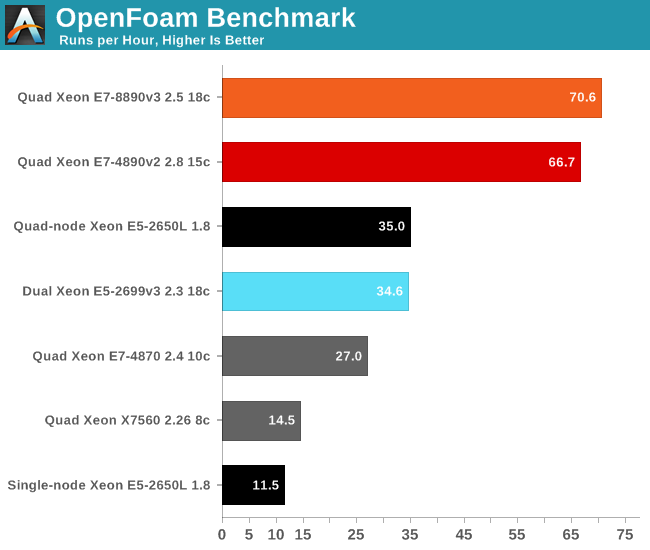The Intel Xeon E7-8800 v3 Review: The POWER8 Killer?
by Johan De Gelas on May 8, 2015 8:00 AM EST- Posted in
- CPUs
- IT Computing
- Intel
- Xeon
- Haswell
- Enterprise
- server
- Enterprise CPUs
- POWER
- POWER8
HPC: OpenFoam
Computational Fluid Dynamics is a very important part of the HPC world. Several readers told us that we should look into OpenFoam, and my lab was able to work with the professionals of Actiflow. Actiflow specializes in combining aerodynamics and product design. Calculating aerodynamics involves the use of CFD software, and Actiflow uses OpenFoam to accomplish this. To give you an idea what these skilled engineers can do, they worked with Ferrari to improve the underbody airflow of the Ferrari 599 and increase its downforce.
We were allowed to use one of their test cases as a benchmark, but we are not allowed to discuss the specific solver. All tests were done on OpenFoam 2.2.1 and openmpi-1.6.3.
Many CFD calculations do not scale well on clusters, that is unless you use InfiniBand. InfiniBand switches are quite expensive and even then there are limits to scaling. We do not have an InfiniBand switch in the lab, unfortunately. Although it's not as low latency as InfiniBand, we do have a good 10G Ethernet infrastructure, which performs rather well. So we can compare our newest Xeon server with a basic cluster.
We also found AVX code inside OpenFoam 2.2.1, so we assume that this is one of the cases where AVX improves FP performance.

Unless you recompile and tune your code for AVX2, the new Xeon E7 v3 is hardly faster than the previous one. The reason may be that the new Xeon can sometimes go as low as 2.1 GHz running AVX code due to the immense power load AVX2 workloads can cause, while the older E7 v2 is capable of sustaining 2.8 GHz.










146 Comments
View All Comments
TheSocket - Friday, May 8, 2015 - link
They sure wouldn't lose the x86-64 license since they own it and Intel is licensing it from AMD.melgross - Saturday, May 9, 2015 - link
But without the license from Intel, it is worthless. There's also the question of how that works. I believe that Intel doesn't need to license back the 64 bit extensions.Kevin G - Monday, May 11, 2015 - link
This one of the reasons why it would be in Intelsat best interest to let AMD be bought out with the 32 bit license intact. The 64 bit license/patents going to a third party that doesn't want to share would be a dooms day scenario for Intel. Legally it wouldn't affect anything currently on the market but it'd throw Intel's future roadmap into the trash.Death666Angel - Saturday, May 9, 2015 - link
Pretty sure some regulatory bodies would step in if Intel were the only x86 game in town. And x86-64 is AMD property.JumpingJack - Saturday, May 9, 2015 - link
Any patents on x86 are long expired, AMD only owns the IP related to the extension of the x86 not the instruction set.patrickjp93 - Monday, May 11, 2015 - link
Not true. The U.S. government has them locked up under special military-based protections. Absolutely no one can make and sell x86 without Intel's and the DOD's permission.Kevin G - Monday, May 11, 2015 - link
Got a source for that?I know that DoD did some validation on x86 many years ago. (The Pentium core used by Larrabee had the DoD changes incorporated.)
haplo602 - Friday, May 8, 2015 - link
hmm ... where's the RAS feature comparison/test ? did I miss it in the article ?TeXWiller - Friday, May 8, 2015 - link
In the E7v3 vs POWER comparison table, there should be 32 PCIe lanes instead 40 in the Xeon column.TeXWiller - Friday, May 8, 2015 - link
Additionally, it is the L3 in POWER8 that runs half of the core speed. L2 runs at the core speed.